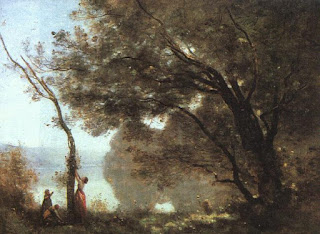It is tempting to think of the beginning of Impressionism to be the 1874 Salon de' Refuse' in which seven renegade artists, Monet, Renoir, Pissarro, Sisley, Degas, Cezanne, and Berthe Morisot, organized their own artistic statement in defiance of the official Salon. Of course1874 is merely the flashpoint. Every one of the artists mentioned were over 30 at the time and had been pursuing their brand of Impressionism for five to ten years. Each were schooled to some degree by the Ecole des Beaux-Arts and every one of them had been influenced to varying degrees by those historical tributaries that had flowed into the Impressionist river then starting to meander through the French art landscape.
 |
Entrée du village de Voisins, 1872,
Camile Pissaro |
To get a feel for what and why Impressionism was, we must rewind back to 1855 to the Paris World's Fair. As seen through the eyes of Camille Pissarro, who arrived in Paris from his native St. Thomas in that year, the Palais des Beaux-Arts must have seemed as bewildering as a carnival fun house. Showing over 2,000 works by artists from 28 different nations. The show was really a thinly disguised conflict between three men, Jean-Aguste Ingres (prounouced Ang), Eugene Delacroix, and Gustave Courbet. Ingres and Delacroix were featured artist at the exhibit with 35-40 canvases each. Courbet was the upstart outsider, disgruntled that two of his best works had been rejected, he built, at his own expense, a separate pavilion in which he displayed about 35 of his works. Lesser artists such as Corot had only 6 works displayed, Daubigny even fewer, and Millet only one.
 |
Mortefontain, 1864,
Jean-Baptiste-Camile Corot |
Yet as a painter of tropical landscapes, it was these lesser-knowns that impressed the artistically naive young Pissarro. And, it was Corot to whom he turned for guidance. A certain courage was required to do so in that Corot's work was still seen as mere color sketches, his students following the path of least resistance under his banner. That path led outdoors, through the Fountainbleu forest, and straight to the Barbizon painters who had, for the previous 25 years, trekked south of Paris to its pristine, verdant beauty. Here, a devotion to nature deprived the public of what it liked most in painting, a story told by an artist of historical or anecdotal subjects. Here was a "democratic" art of rural roots intolerable to those of refinement and tastes. It was here, almost 20 years before they bore fruit, that the seeds of Impressionism were planted.




No comments:
Post a Comment